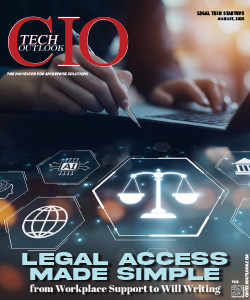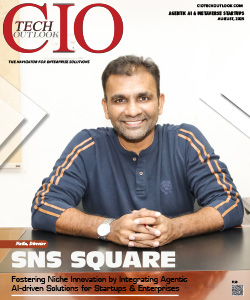Investing in Training and Empowering Teams with the Latest Skills
Rajeev Ranjan, COO, Ness Digital Engineering
 Rajeev Ranjan, COO, Ness Digital Engineering in an interaction with CIOTechOutlook shared his views on how can companies align their training investments with long-term business goals, the risks of not investing in continuous team upskilling in today’s fast-evolving tech landscape and more.
Rajeev Ranjan, COO, Ness Digital Engineering in an interaction with CIOTechOutlook shared his views on how can companies align their training investments with long-term business goals, the risks of not investing in continuous team upskilling in today’s fast-evolving tech landscape and more.
Rajeev Ranjan is an accomplished technology and business leader with over three decades of experience driving large-scale technology-led transformations. As the Chief Operating Officer at Ness Digital Engineering, he plays a pivotal role in shaping business strategy, fostering innovation, and delivering tangible value to clients.
How can companies align their training investments with long-term business goals?
In today’s business environment and rapidly changing technology landscape, the definition of ‘horizon’ has changed. Beyond 1 year can be safely construed as long-term and so the training investments have to be balanced between the immediate-term and long-term.
Traditionally business plans were limited to revenue plans (on the demand side) and their co-relation to headcount (on the supply side). But now it has to be extended to headcount by skills (technology or domain or managerial) and the challenge is that not all of it is readily available in the market. There is where re-skilling and upskilling come into play by being an alternate source of talent supply.
If an organization is able to do the headcount planning at the level of skills, then depending on the quantum that needs to be trained within the existing workforce, it should determine the investments required in training.
Training should address real business challenges, whether it's closing current skill gaps or preparing for the future. That’s why we follow a dual-skilling approach:
- Skill to Order: tackles immediate business needs and bridges current skill gaps.
- Skill to Stock: builds capabilities for tomorrow, creating a pipeline of future-ready talent.
We also track Time to Skill and Time to Productivity to ensure learning translates to real impact, fast. We personalize learning by role, project, and growth path, keeping it relevant and results focused.
What are the risks of not investing in continuous team upskilling in today’s fast-evolving tech landscape?
We are all getting outdated in expertise and skills faster than what we think (or quite secretly presume). Things are moving fast. New tools, new frameworks, AI everywhere and if your team isn’t keeping up, the gap between what they know and what the business needs just keeps growing.
When companies skip upskilling, teams stall, projects slow down, quality dips, and top talent walks out. People want to grow, and if they can’t, they leave.
There is also a very important element of business growth related to team upskilling. The projects teams are best equipped to understand the client’s IT landscape. They are the best-informed people to recommend to the client ways of making the landscape more nimble, modern, scalable, cost-effective, and maximize business value. Else the team risks de-growth of their business due to competition sneaking in. Hence, it is best to invest to have the project team upskill themselves and be more relevant to the client.
One-off training doesn’t cut it either. Thanks to the “forgetting curve,” most of what’s learned is gone in a month without real-world use. A McKinsey study found 43% of employees trained in future tech never applied their skills within six months. That’s not just wasted training; it’s lost momentum. Continuous learning isn’t a luxury anymore. It’s the only way to stay competitive and keep your people engaged.
How do you measure the ROI of employee training and skill development programs? What role does leadership play in building a culture of continuous learning?
Measuring ROI on training isn’t just about counting certifications, it’s about impact. We focus on two metrics: Time to Skill (how fast someone learns) and Time to Productivity (how quickly that learning drives results). It’s not enough to learn Python or earn an AWS badge. We ask if it helped solve a problem, speed up delivery, or add value to a project.
If we roll-up the above two metrics to the overall metrics of Talent Supply Chain, it should lead to improvement in demand-fulfilment lead time, higher percentage of fulfilment through existing workforce, and therefore reduction in revenue loss due to fulfilment.
Leadership is key here. Learning cultures thrive when leaders champion them. When they align training with business goals, support teams through the reskilling curve, and celebrate progress, learning becomes mission-critical, not a side initiative. Also, we have seen firsthand how executive sponsorship transforms training into real growth for individuals and the business.
How can organizations ensure training initiatives empower—not overwhelm—employees? How can training programs be made more inclusive across diverse roles and learning styles?
This can be achieved by designing just-in-time, just-right learning experiences that are tightly aligned to what people actually need in their roles.
Because people learn differently, we offer a blend: microlearning, bootcamps, peer groups, and self-paced modules to fit varied styles and schedules. With GenAI, we personalize paths, so a backend developer gets what they need, not a curriculum as a data analyst, because their needs and goals are different. When learning is relevant and manageable, it empowers, not overwhelms.
The above is enabled by a training platform that hosts internal content, links to external certifications & courses, and personalized reports on individuals' learning plan.
What frameworks can help SMEs or startups invest in skill development without large budgets?
When budgets are tight, skill development isn’t a luxury; it’s a smart strategy. It’s less about spending and more about alignment and impact. Focus on what skills drive business goals today, and embed learning into daily work through mentorship, projects, and collaboration.
Free or low-cost resources, including government programs and open-source content, can go a long way. What counts is application, not just participation—when employees apply learning and managers support it, ROI follows.
For instance, we use practical frameworks that SMEs and startups can adopt:
- 70-20-10 Model: 70% on-the-job, 20% peer learning, 10% formal training.
- T-shaped Skills: Deep expertise in one area, broad knowledge across others using free/internal resources.
- Lean Learning Loops: Build, measure, and iterate small learning modules for quick, low-cost impact.




.jpg)